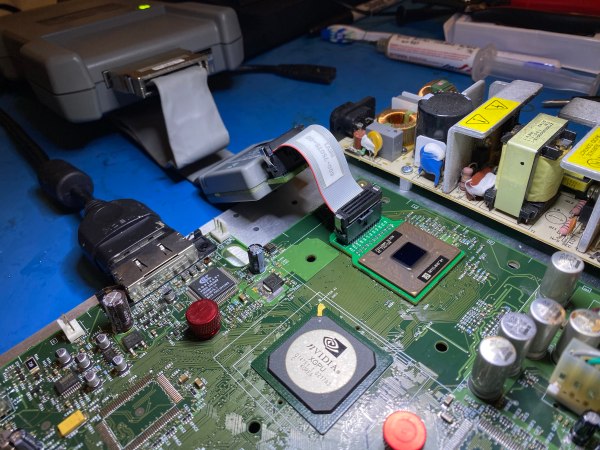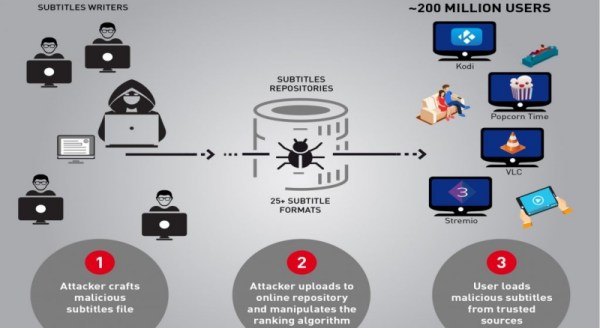
XBMC (formerly Xbox Media Center) has always been a popular choice for retiring an original Xbox. Maybe people install it for lack of something better to do or maybe it’s the pride in having better media support than the 360. The XBMC team has found another device that has a pretty weak television experience, the Mac. Lifehacker took the latest XBMC for OSX beta build for a run now that it supports remote controls. It seems like a much more functional than Apple’s built in Front Row. There are a few things that don’t quite work yet, which you can find in the FAQ. We’re definitely going to try this on our old Mac mini… once we upgrade it to Leopard, which is an unfortunate caveat that might prevent people from running XBMC on legacy hardware. There is no Apple TV support planned because of limited horsepower and the hacking hurdles that might be required. If you’re interested in repurposing your old Xbox with XBMC, check out Lifehacker’s install guide.
Using JTAG To Dump The Xbox’s Secret Boot ROM
When Microsoft released its first entry into the video game console market with the Xbox, a lot of the discussions at the time revolved around the fact that it used a nearly off-the-shelf Intel CPU and NVIDIA GPU solution. This made it quite different from the very custom consoles from Nintendo and Sony, and invited thoughts on running custom code on the x86 console. Although the security in the console was hacked before long, there were still some open questions, such as whether the secret boot ROM could have been dumped via the CPU’s JTAG interface. This is the question which [Markus Gaasedelen] sought to answer.
The reason why this secret code was originally dumped by intercepting it as it made its merry way from the South to the North Bridge (containing the GPU) of the Xbox was because Microsoft had foolishly left this path unencrypted, and because the JTAG interface on the CPU was left disabled via the TRST# pin which was tied to ground. This meant that without removing the CPU and adding some kind of interposer, the JTAG interface would not be active.
A small issue after the harrowing task of desoldering the CPU and reinstalling it with the custom interposer in place was to keep the system integrity check (enforced by an onboard PIC16 MCU) intact. With the CPU hooked up to the JTAG debugger this check failed, requiring an external injection of the signal on the I2C bus to keep the PIC16 from resetting the system. Yet even after all of this, and getting the secret bootrom code dumped via JTAG, there was one final system reset that was tied to the detection of an abnormal CPU start-up.
The original Xbox ended up being hacked pretty thoroughly, famously giving rise to projects like Xbox Media Center (XBMC), which today is known as Kodi. Microsoft learned their lesson though, as each of their new consoles has been more secure than the last. Barring some colossal screw-up in Redmond, the glory days of Xbox hacking are sadly well behind us.
The Mini Console Revolution, And Why Hackers Passed Them By
The Raspberry Pi was initially developed as an educational tool. With its bargain price and digital IO, it quickly became a hacker favorite. It also packed just enough power to serve as a compact emulation platform for anyone savvy enough to load up a few ROMs on an SD card.
Video game titans haven’t turned a blind eye to this, realising there’s still a market for classic titles. Combine that with the Internet’s love of anything small and cute, and the market was primed for the release of tiny retro consoles.
Often selling out quickly upon release, the devices have met with a mixed reception at times due to the quality of the experience and the games included in the box. With so many people turning the Pi into a retrogaming machine, these mini-consoles purpose built for the same should have been immediately loved by hardware hackers, right? So what happened?
Continue reading “The Mini Console Revolution, And Why Hackers Passed Them By”
Hackaday Celebrates 15 Years And Oh How The Hardware Has Changed
Today marks exactly 15 years since Hackaday began featuring one Hack a Day, and we’ve haven’t missed a day since. Over 5,477 days we’ve published 34,057 articles, and the Hackaday community has logged 903,114 comments. It’s an amazing body of work from our writers and editors, a humbling level of involvement from our readers, and an absolutely incredible contribution to open hardware by the project creators who have shared details of their work and given us all something to talk about and to strive for.
What began as a blog is now a global virtual hackerspace. That first 105-word article has grown far beyond project features to include spectacular long-form original content. From our community of readers has grown Hackaday.io, launched in 2014 you’ll now find over 30,000 projects published by 350,000 members. The same year the Hackaday Prize was founded as a global engineering initiative seeking to promote open hardware, offering big prizes for big ideas (and the willingness to share them). Our virtual connections were also given the chance to come alive through the Hackaday Superconference, Hackaday Belgrade, numerous Hackaday Unconferences, and meetups all over the world.
All of this melts together into a huge support structure for anyone who wants to float an interesting idea with a proof of concept where “why” is the wrong question. Together we challenge the limits of what things are meant to do, and collectively we filter through the best ideas and hold them high as building blocks for the next iteration. The Hackaday community is the common link in the collective brain, a validation point for perpetuating great ideas of old, and cataloging the ones of new.
Perhaps the most impressive thing about the last 15 years of Hackaday is how much the technological landscape has changed. Hackaday is still around because all of us have actively changed along with it — always looking for that cutting edge where the clever misuse of something becomes the base for the next transformative change. So we thought we’d take a look back 15 years in tech. Let’s dig into a time when there were no modules for electronics, you couldn’t just whip up a plastic part in an afternoon, designing your own silicon was unheard of, and your parts distributor was the horde of broken electronics in your back room.
Continue reading “Hackaday Celebrates 15 Years And Oh How The Hardware Has Changed”
How The Xbox Was Hacked
The millennium: a term that few had any use for before 1999, yet seemingly overnight it was everywhere. The turning of the millenium permeated every facet of pop culture. Unconventional popstars like Moby supplied electronica to the mainstream airwaves while audiences contemplated whether computers were the true enemy after seeing The Matrix. We were torn between anxiety — the impending Y2K bug bringing the end of civilization that Prince prophesied — and anticipation: the forthcoming release of the PlayStation 2.
Sony was poised to take control of the videogame console market once again. They had already sold more units of the original PlayStation than all of their competition combined. Their heavy cloud of influence over gamers meant that the next generation of games wasn’t going to start in until the PS2 was on store shelves. On the tail of Sony announcing the technical specs on their machine, rumors of a new competitor entering the “console wars” began to spread. That new competitor was Microsoft, an American company playing in a Japanese company’s game.
Continue reading “How The Xbox Was Hacked”
Hacked By Subtitles
CheckPoint researchers published in the company blog a warning about a vulnerability affecting several video players. They found that VLC, Kodi (XBMC), Popcorn-Time and strem.io are all vulnerable to attack via malicious subtitle files. By carefully crafting a subtitles file they claim to have managed to take complete control over any type of device using the affected players when they try to load a video and the respective subtitles.
According to the researchers, things look pretty grim:
We estimate there are approximately 200 million video players and streamers that currently run the vulnerable software, making this one of the most widespread, easily accessed and zero-resistance vulnerability reported in recent years. (…) Each of the media players found to be vulnerable to date has millions of users, and we believe other media players could be vulnerable to similar attacks as well.
One of the reasons you might want to make sure your software is up to date is that some media players download subtitles automatically from several shared online repositories. An attacker, as the researchers proved, could manipulate the website’s ranking algorithm and not only would entice more unsuspecting users to manually download his subtitles, but would also guarantee that his crafted malicious subtitles would be those automatically downloaded by the media players.
No additional details were disclosed yet about how each video player is affected, although the researchers did share the details to each of the software developers so they can tackle the issue. They reported that some of the problems are already fixed in their current versions, while others are still being investigated. It might be a good idea to watch carefully and update your system before the details come out.
Meanwhile, we can look at the trailer:
Pimped Out 70’s Home Intercom System, Now With More Pi
If you own a house that was built in the 1970’s, you might still have the remnants of a home intercom system on the walls of each room. They were consider the end-all-be-all of “home automation” back in the day. Now, they look dated and out of place (but still kind of retro-cool at the same time). [Cpostier] decided that he wanted to keep his old intercom system, but give it an update with a Rasperry Pi and a 7 inch touch screen, and the results are totally groovy, man.
The original unit served two functions, as an intercom system, and also as a whole house music player. [Cpostier] wasn’t interested in the intercom feature, and so he started with the traditional gutting of the 70’s dried up electronics. Each room received a new $7 speaker (from Amazon), and the main control panel was fitted with a Pi, TFT touch screen, and new amplifier. The Pi is running Kodi (formerly know as XBMC) and along with it being a great media player, it can also show weather data, or what ever else you would like.
Something magical happens when you blend new tech with old tech – we totally dig it.















